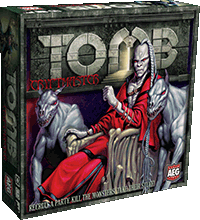I’m a sucker for a good dungeon hack. You go in, you kill some monsters, you loot some boxes, you raise some levels. Lather. Rinse. Repeat. It has worked for decades with so many different games and systems, that having a few board games like that is always nice. Sometimes you just don’t want to deal with the nuances of role-playing, but still want all of the fun statistical destruction with flavor text characters.

The Tomb Board game
That’s what I hoped I would be getting with Tomb. In this game, you and the other players build a dungeon together, and then you play as the merc who is hiring his team to go into the tomb to kill the baddies and heist the loot. The interestingly different take on the whole game is that all of you are doing this against each other. There is not a drop of teamwork to be found in this game, except for maybe a couple people ganging up on another. Individually, you lay out the map, planting little gifts for yourself and putting monsters down to annoy your enemies. You must remember that your opponents are doing this too. You then “Hire Some Heroes” to go and get all of that delicious treasure.
That’s the premise of Tomb, and on paper it sounds like a fantastically different take on the genre.
Tomb Instructions
The first thing you do is build up your dungeon. Each of the crypts has a number, which dictates how many treasure cards it gets. Now I say treasure cards, because that is what you are really hoping for, but amongst them are also traps and monsters. The hope is that you drop a few treasures in places that you remember. There are a few spots with only ‘1’ there, so it is also good to note who put things in those spots. This is where we found a lot of the smack talk of the game began.
After you have laid out a card, somebody would look at you and put down their own card with a ‘So, did I just make that a monster so you can’t get your treasure?’ or ‘Well now I know to avoid this area’ Reasonably though, there are so many places on the board for things to go, you kind of forget where you put things. I assume this is expected, as in the few games I’ve tried of Tomb, you always remember where you put the best item or worst monster, and everything else is a crapshoot. More than once, somebody would flip over the card and go, ‘THAT’S where I put it.’ So does this chunk of the game really matter? I guess it comes down to a house rule, and you could do it all randomly, but we enjoy it.
The next section of the game involves making your party. This is what I really liked about Tomb. It takes you step by step through the dungeon dwelling process, and a lot of it is ‘Do one action. Next player’s turn.’ It presents a lot of opportunity to mess with the other players, which is really what this game is good at. So in the inn, which gets its own stylish sideboard, each person picks up a hired hero to help them go spelunking. You have the standard fighter, thief, mage, cleric to pick from. On your turn you can also outfit them with weapons, items, and spells. Only one thing per turn though, which means if you want to load up your guys with armor and weapons and magic, you are wasting time by not being in the dungeon.
Tomb Rules
The stat system is an exceptionally neat and interesting way to roll and fight. It is all based on three different color dice that have a different number of ‘success’ sides. So a fighter may have as their attack: 2 red, 2 green. The reds have the most amount of success spots, green the second, and blue the last. The various characters all have similar stats in attack, skill, magic, and holy. Each gets its own dice pool to work with. Roll that amount, count up successes, that’s it.
So once your party is traversing the dungeon, you are going to inevitably enter a crypt. The player to your left takes the cards and is the makeshift GM for the moment. (They call it the Cryptmaster, but we know what it really is) In turn, the Cryptmaster plays traps, monsters, and then if you succeed, treasure. This though, the point in the game that should really shine, is where it falls apart a bit.
The rulebook is very thin. It does a good job at being succinct, but might fall into the ‘too succinct’ variety. Monsters, spells, items, and even characters all have the ability to have special abilities. The real problem is that there is no defining words used. Sometimes the card says ’round’ and sometimes it says ‘turn’. Sometimes it even says ‘phase’. These are all three terms that can be the exact same thing, or drastically different, but it didn’t seem that there was any standard dictated by the rules or the cards themselves. This ended up turning almost every combat into a pause to reflect on what the intent of the rule was, as compared to what it actually said. We really started to believe that all of these cards had been poorly translated from another language.
Tomb Strategy
The first big hurdle to get past in this is the first game. Afterwards, you will have a handle on the play control and what the rules are going for. Let this be your first strategy: Agree on rules for the second game. Generally, the order in which things happen and the ‘break the rules’ mentality of the cards is a great idea, as the basics are so simple, but when you have a character and a monster that have two drastically opposing rules, everything becomes a judgement call.
The next thing to know about the game is that you shouldn’t care about your characters. They are hired help, not friends. Don’t worry that you just lost your entire team to a dragon, just take your turns to build a new party and get back in there!
I wish Tomb didn’t have such a big gaping wound. It is a simple game with a great premise that could be hours of fun, but after the first game we felt so frustrated we put it down for a few months. Trying it a second time only meant going through it all over. It was only after that did we start creating our set of house rules, and come to find that we’re not the only ones. There are FAQs out there dedicated to just making Tomb work. Is it a worthy game? Yes, but needs some effort on the part of the players, and probably shouldn’t be your first experience in more complex board games.




